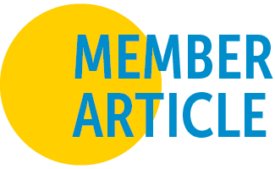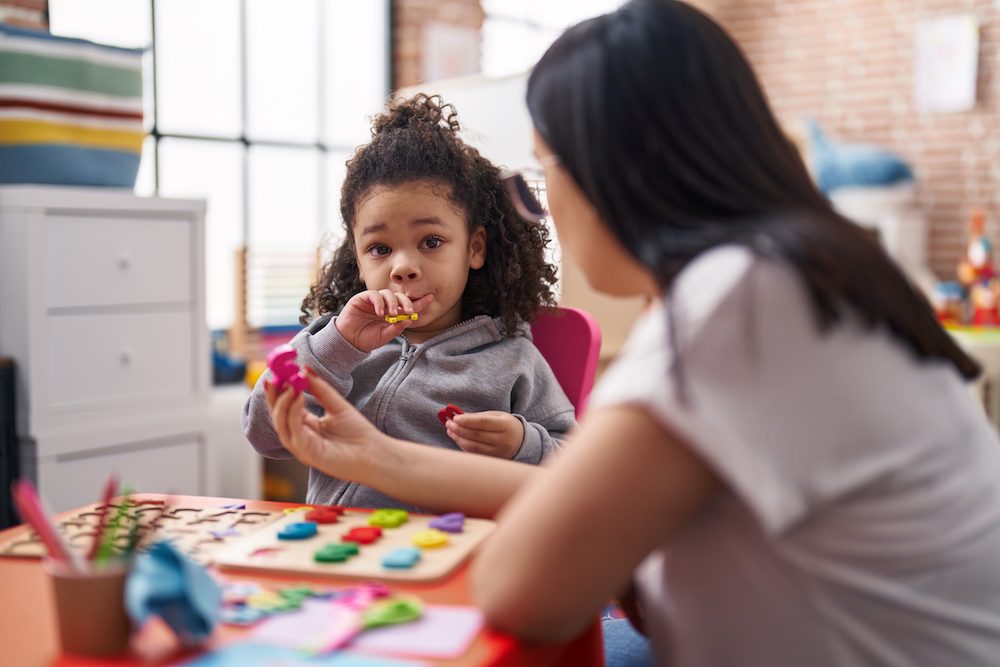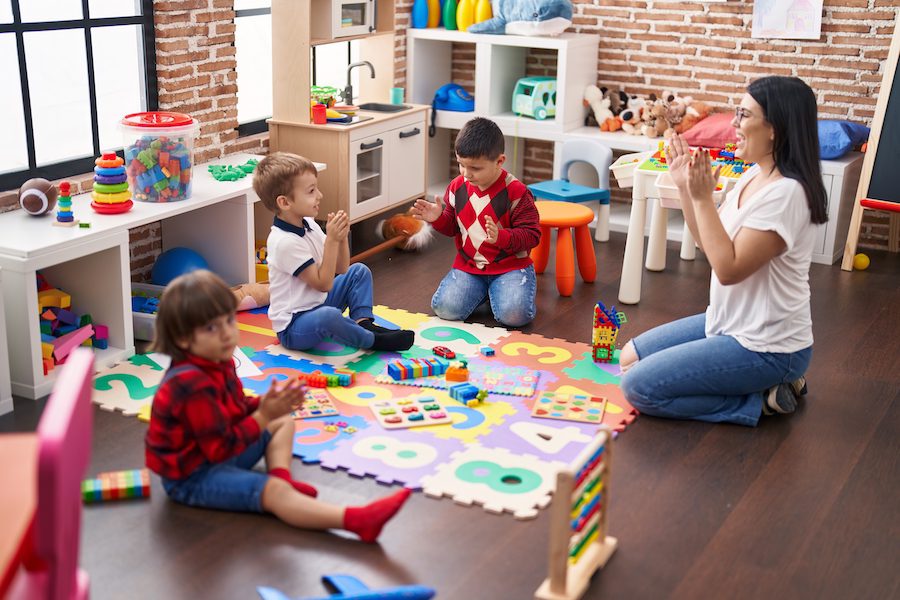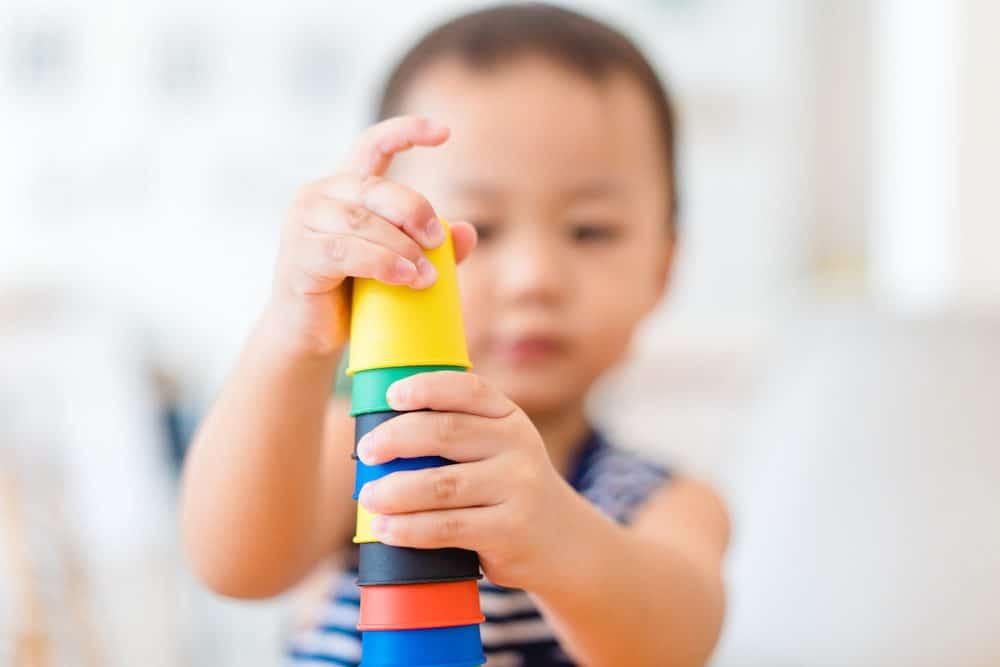
Equity and Early Math Experiences: Equity-Based Instructional Practices in an Early Math Curriculum for Toddlers and Preschoolers

Abstract
The learning that happens before school entry provides children with a strong foundation on which to build new conceptual understandings. In particular, mathematical skills predict later math and reading outcomes in elementary school. This article summarizes existing research on equity-based math instructional approaches and provides a rationale for translating and applying 10 of these teaching practices to toddler/preschool early learning settings.
While traditionally math instruction has begun in kindergarten, all learning—including the development of math knowledge—begins at birth. Age-appropriate early learning experiences offer children the opportunity to build foundational skills that predict their academic performance into elementary school (Duncan, et al., 2007; Watts et al., 2018). For young children, this important learning must happen through play and exploration, and through activities that engage their curiosity and drive to understand the world around them. Taking a joyful and playbased approach to learning yields dividends: research shows that the more curious children are prior to school entry, the better they do academically in reading and math once they enter school (Shah et al., 2018).
The learning that happens before school entry provides children with a strong foundation on which to build new conceptual understandings. Early mathematics skills, in particular, have strong predictive power for both math and reading outcomes in elementary school (Duncan et al., 2007). A longitudinal study that followed 4-year-olds through elementary school found that preschool math skills (specifically, nonsymbolic quantity, counting, and patterning knowledge) predicted fifth-grade mathematics achievement (Rittle-Johnson et al., 2016). These and other studies are often used to argue for the importance of early mathematics in early childhood education and care settings (ten Braak et al., 2022). In short, early advantages pay dividends. Critical math learning is happening in the years prior to kindergarten entry—but only if children have access to the rich learning experiences that promote exploration and mastery.
In 2021–2022, ZERO TO THREE received funding support to develop an age-appropriate, play-based early math curriculum. Problem Solvers, released in September 2022, is a free, downloadable set of 22 early math activities and songs, designed to support emerging math knowledge across six domains of math for children from 2.5 through 4 years old. This curriculum resource is available free of charge, as one of ZERO TO THREE’s goals was to support those community-based early education programs that may otherwise be unable to acquire research-based math curricula. This article explores the ways in which equity issues are central to how, and how often, mathematics is part of early education experiences and outlines the equity-centered principles the curriculum authors used in developing Problem Solvers.
Exposure to Early Math Experiences as an Equity Issue
Research has established significant race-based gaps between the reading and math skills of both White and Asian children and the reading and math skills of Black and Hispanic children at kindergarten entry (García, 2015). Yet these race-based data don’t tell the whole story. Rather, they convey a powerful narrative of access, rather than race and ability.
Poverty is a powerful and shaping influence on children’s development. An Economic Policy Institute report framed the issue in this way, “Race-based skills gaps shrink significantly” when children’s social class/family income is taken into account (García & Weiss, 2015). The authors explained:
In real life we cannot disentangle black and Hispanic children’s race and ethnicity from the contexts in which they live, which put them at a major disadvantage relative to their average white and Asian peers. It is not race itself, then, but the poverty and other things that too often go along with being a minority child in America, that compound disadvantage (emphasis added).
To examine the impact of growing up in underserved, under-resourced communities, the Brookings Institution (Isaacs, 2012) analyzed school readiness patterns from a nationally representative sample of children from birth through kindergarten entry. Nearly one quarter (23%) of children in the sample were born into families living in poverty, another quarter (25%) of children fell into the near-poverty group, and the remaining half (52%) were classified as having moderate or higher income.
Children who were members of families living in poverty were much more likely than other children to score very low on math and reading skills. In fact, 26% of children living in poverty and 19% of children living in near poverty lacked the math skills they needed to be considered “school ready” at kindergarten entry (Isaacs, 2012). Yet research indicates that early risk can be mitigated or remediated through high-quality early learning experiences and instructional strategies (Presser et al., 2015). Furthermore, research demonstrates that preschool children can attain higher levels of understanding in mathematics, with gains maintained into kindergarten, when they are supported through well-planned, stimulating, and developmentally appropriate activities (Starkey et al., 2022).
Yet early educators often receive little formal training in designing meaningful and age-appropriate foundational math experiences for children across the first 5 years. How does this gap in professional preparation impact practice? The Transforming the Workforce report (Institute of Medicine & National Research Council, 2015) asserts that subjects such as mathematics and science usually are underemphasized for young children. One study—in which researchers coded the time spent on various academic activities in preschool settings—found, on average, children spent only approximately 8 minutes per day in math and science learning activities (Connor et al., 2006); another study focused specifically on preschools serving working- and middle-class families, and found that 60% of settings offered 3-year-olds no mathematical experience of any kind across 180 observations (Tudge & Doucet, 2004). A more recent study of 65 preschool classrooms (Piasta et al., 2014) found that children experienced an average of 24 minutes of math learning opportunities per day. Too often, a lack of knowledge about early math instructional practices translates to a lack of exposure to math experiences in the early education setting.

Equity-Centered Early Math Instructional Practices
Increasingly, there has been a focus on integrating equity-based practices with math instructional approaches, for many of the reasons outlined in the previous section. This effort initially focused on elementary math instruction (Aguirre et al., 2013; Gutiérrez, 2012; Jackson et al., 2021; Polly, 2021) but increasingly, professionals in early childhood systems have begun considering the ways in which equity-centered instructional practices can support children’s mathematics learning even before formal schooling begins. In developing Problem Solvers, my co-creators and I reviewed science, technology, engineering, and mathematics (STEM) education frameworks and recommended practices for equity-based instruction in STEM domains (Equitable Math, 2021; Gutiérrez, 2012; Jackson et al., 2021; National Council of Teachers of Mathematics, 2014) and identified those approaches we felt were most appropriate for early education environments.

Ultimately, the following 10 equity-based math instructional approaches shaped the development of the Problem Solvers curriculum. Each describes a specific teacher action, approach, or stance that seeks to meet learners’ diverse needs and lived experiences, and centers children’s cultural assets and strengths (Delpit, 2012). These instructional practices are also appropriate for early childhood settings, specifically those classrooms serving children 2.5 to 5 years old, and reflect the developmental capacities of older toddlers and preschoolers. The following list of instructional practices is not exhaustive. It is an initial effort to articulate the ways in which early educators can consider, respond to, and nurture the rich and diverse lived experiences, cultures, perspectives, and languages children bring with them when designing and implementing early math curricula.
Practice 1: Provide every child with rigorous math instruction
(Aguirre et al., 2013; Equitable Math, 2021). For too long, math aptitude has been perceived as the result of innate ability (i.e., the notion that one is “good at math” or “bad at math”), rather than the result of rigorous, organized learning experiences. For children whose identities (e.g., race, class, gender, ethnicity, language) place them outside the mainstream culture’s perception of those who are “good at math,” the risks are high: researcher Lisa Delpit (2012, p. 6) explained, “What happens when we assume that certain children are less than brilliant? Our tendency is to teach less, to teach down, to teach for remediation.” To disrupt this cycle, Practice 1 asserts that every child in every early childhood program has the right to experience rigorous math curricula and learning experiences. Equitable teaching unfolds in environments where children access, apply, and explore rigorous mathematics in age-appropriate ways that build deep conceptual understanding.

Practice 2: Differentiate instruction to allow for productive struggle (Equitable Math, 2021). Building on Practice 1, Practice 2 explicitly acknowledges that all learners (even infants) enter their early childhood settings with some understanding of mathematics. Observing children’s strengths, understanding their next-expected skills, and remaining attuned to their interests and needs help educators provide learning experiences that are appropriately challenging (rigorous but achievable) and, when needed, implement accommodations that are “truly (and not overly) helpful” (TERC, 2021). Taking a strengths-based approach begins to dismantle the “deficit discourse” around mathematics. Deficit discourses focus on students’ “academic and intellectual shortcomings with little to no recognition of their existing understandings and strengths” and attribute these shortcomings to “deficiencies located in students themselves, their families or their culture” (Adiredja & Louie, 2020, p. 42). How are deficit discourses connected to math? Media messaging, policy documents, research, and other groups have promoted and repeated a consistent message of race-based “achievement gaps,” which is a prominent deficit discourse that “has produced a false and oppressive racial hierarchy of mathematics ability” and one that positions students of color as “less deserving of meaningful, prestigious, and lucrative learning opportunities” (Adiredja & Louie, 2020, p. 43). In this way, deficit discourses about what is acceptable demonstrated math learning merge with deficit discourses about the abilities of children from historically marginalized groups, resulting in learning environments where, too often, students of color are not offered the rich and challenging curricula they need and deserve in order to thrive as learners.
In response to this dynamic of deficit discourses, the authors of Problem Solvers sought to ensure all toddlers and preschoolers have access to challenging math curricula. To achieve this, typical age-based developmental expectations are provided for each activity in Problem Solvers. The authors then developed each activity to meet a typical 3-year-old’s skill set and provided strategies that educators could use to increase or decrease the level of difficulty for children to make the process of individualization easier and more transparent. In post-pilot interviews with teaching staff, participating educators noted that this final element—guidance on individualization—was particularly useful. In one program, teachers explained that they had a 3-year-old who was more advanced than his peers in math skills, so the curriculum’s clear guidance on how to offer more rigor was a support for teachers and a source of excitement for the child. One child’s parents also shared, “We get information about early literacy a lot, but almost never get information about math. He loved the [Problem Solvers parentchild] activities.”
Practice 3: Approach errors as opportunities for learning (Equitable Math, 2021). This practice also works against the deficit discourse approach by framing errors as opportunities to better understand the knowledge and thinking a child is using in a particular activity. The Problem Solvers curriculum normalizes errors as an expected part of the learning process and prompts teachers to invite children to show or tell what they were thinking about a question or activity. This practice offers teachers a window into students’ existing funds of knowledge and helps them apply the constructivist principle of building new skills on a foundation of current skills. Educators can invite discussions about children’s thinking so they can clarify miscommunicated knowledge (Equitable Math, 2021) and provide targeted opportunities for mastery. Normalizing errors also models persistence and curiosity, both approaches to learning that are central to mathematics mastery. Creating this culture of co-discovery in the early education setting can lead to a dynamic in which children and adults together use errors as opportunities for reflection and knowledge growth. In the curriculum, guidance to teachers often prompts them to ask children to share their thinking. For example, one activity asks children to observe several sets of objects and prompts teachers to ask, “Are there any sets that have the same number? Tell me how you know.” Or, “What can we do to make sure there are the same number of cars in each set? Show me what you’d like to try.” In another activity, the teacher is prompted to ask questions like, “When [we added to our line], we added one more. What can we do to find out how many we have in our line now? What has happened to our line since [we added items to our line]? Does the line look different to you? What’s different?” Questions like these offer insight into children’s existing knowledge and problem-solving strategies. When errors or misunderstandings cease to be a source of embarrassment or shame, children are freed to consolidate new knowledge and master increasingly complex skills.
Practice 4: Affirm children’s math identities (Aguirre et al., 2013; Equitable Math, 2021). All children have the right to see themselves as confident problem solvers who can make valuable mathematical contributions. At every age, children should be lifted up as skilled math thinkers with the capacity to learn and grow within the discipline; to contribute to the mathematics understanding of their learning community; and to have their ideas viewed as meaningful contributions to the classroom discourse (TERC, n.d.). This notion of identity is central to learning, as many students experience classrooms as “racialized spaces, where Black and Latina/o students are subject to negative stereotypes about their ability to do mathematics” (Nasir, 2016, p. 11). Existing research on the presence of implicit bias in early education lends support to the notion that birth-to-5 learning environments are also racialized spaces for very young children (Gilliam et al., 2016). As mentioned previously, discourses on math learning often frame this domain as one in which there are those who “can and those who cannot do mathematics” and individuals are “left to identify with one of these two groups, positioning themselves within—or outside of—the mathematics community” based on feedback and messages they receive about their ability (Cribbs et al., 2022, p. 70). These messages often begin even before children enter formal schooling, but they are deepened through teacher–child interactions. Teachers communicate to children “what mathematics is, what learning mathematics entails, and who is considered a doer of mathematics” (Barba, 2022, p. 7). The results of these messages over time are powerful: A survey of more than 10,000 students found that “recognition—perceiving that others think one can succeed in mathematics—was a strong predictor of developing mathematics identity” (Cribbs et al., 2015; 2022, p. 6).
The act of intentionally communicating that every child is a valued contributor and thinker in terms of mathematics is central to Practice 3. In fact, the curriculum name, Problem Solvers, was selected to communicate from the outset that all children engaging in these learning experiences possess the curiosity and capacity to master key mathematics concepts. Furthermore, Barba (2022) suggested a range of methods to foster positive mathematical identities, including several that were embedded into Problem Solvers. These include the use of meaningful tasks that include open-ended questions, allow children to develop and test strategies, and focus on explanations (Barba, 2022). In Problem Solvers, children are encouraged to share their thinking and experiment with different approaches. Teachers are prompted to explore children’s ideas through conversations: “What can we do to make a set of four fruits?” Another best practice is to establish classroom norms centered on discourse—where collaboration is encouraged and the teacher is the facilitator of these discussions (Barba, 2022). Each Problem Solvers activity includes a group learning experience and a paired learning experience, where children can work with peers to explore and experiment with new math concepts. For example, in one activity, a child creates a small set of objects (e.g., three objects) and their partner creates a set with “one more.” A third best practice for fostering positive mathematical identity is to provide opportunities for students to reflect on their mathematical journey (Barba, 2022). Each activity concludes with a reflective discussion with children that prompts them to think about and share their learning. For example, the teacher debriefs a counting and comparison activity by asking reflective questions like, “What was tricky about figuring out which sets of cars had more? What did you do to figure out which sets had more and less? What did you do to make a set of blocks with ‘one more’?”


Practice 5: Ground learning within students’ lived experiences (TERC, 2021). When educators tap into the language, experiences, and understandings children bring with them into an early learning setting, toddlers and preschoolers are able to better engage with the curriculum content and access deep and meaningful learning opportunities. To do this, educators can plan learning experiences where children are positioned “as sources of expertise” for solving math problems and develop curricula that taps into, and builds on, children’s existing funds of knowledge related to their culture, community, family, and history (TERC, 2021). In the Problem Solvers curriculum, each activity opens with a discussion of what children know or think about a particular topic. For example, in an activity that uses birthday candles as a means to explore quantities, cardinality, and early addition, the opening discussion invites children to share how they celebrate birthdays with their families.
Practice 6: Integrate math learning across the curriculum (Jackson et al., 2021). Sanders (2009) described integrated STEM education as “approaches that explore teaching and learning between/among any two or more of the STEM subject areas, and/or between a STEM subject and one or more other school subjects” (p. 21). Teaching integrated STEM lessons with older children (K-12) has been found to be a more effective teaching pedagogy when compared with individually teaching the siloed disciplines (Becker & Park, 2011). In Problem Solvers, integration is a natural strategy as young children explore, play, and wonder about the mathematical patterns and relationships they observe in the world around them. In Problem Solvers, early math concepts are embedded into arts (specifically, music) experiences, literacy experiences, and in the case of several activities, science experiences. The songs composed for Problem Solvers prompt children to sing phrases, perform actions, and move their bodies in ways that support early math skills as well as promote early music education outcomes. In the Sorting Our Class song, children are prompted to sort themselves into sets using the rules in the song (“If you are wearing sneakers today, stand right over here. If you are wearing other shoes today, stand right over there.”). In between verses, the teacher pauses the audio and counts the number of children in each set. The books suggested for the literacy component of the curriculum invite use of rich math language around comparisons (e.g., size, color, attributes of shapes); descriptions (e.g., location in space, patterns); and early calculations (e.g., sets of objects or characters increasing or decreasing in size). Science-centered activities include, for example, a learning experience that invites children to explore and recreate the patterns apparent in birdsong. These integrated experiences proved to be some of the most popular components of the curriculum; for example, teachers shared that children often asked for the “math books” even on days when teachers had not planned to read them. Teachers also reflected it was helpful that the “math activities fit into other parts of our curriculum like science.”

Practice 7: Intentionally build physical movement into math activities (Equitable Math, 2021). Equitable math environments offer children a range of ways to participate and engage—for example, through work in small groups, or by incorporating music, song, and movement into learning experiences (Equitable Math, 2021). This practice is especially appropriate for early childhood environments where, developmentally, children have shorter attention spans and a drive to use their new and emerging physical skills to explore the world. Problem Solvers was developed in partnership with an associate professor of music and director of music education, Dr. Jennifer McDonel of Radford University. Dr. McDonel composed and performed a song to align with each of the 22 curriculum activities; this collection of songs offered a secondary pathway for children to experience and explore math concepts. Problem Solvers units describe how to implement each of the songs (also available for free download). Furthermore, almost all of the activities in Problem Solvers invite children to move and explore—whether they are pretending to be birds (in a unit that explores patterns through sounds) or exploring the classroom as garbage trucks on their route (in a unit that explores spatial relationships).
Practice 8: Encourage student-to-student interaction (TERC, 2021). Students become confident learners and develop a strong mathematics identity when they have opportunities to collaborate in solving problems, to learn from one another, and to be supported by their peers in the learning process. Practice 8 asserts that all students have the right to share their ideas and thinking about mathematics, to have others listen respectfully and engage with them around mathematical questions and ideas, and to be seen as valuable contributions to the classroom discourse on mathematics (TERC, 2021). Problem Solvers uses both large-group and partner activities to encourage collaboration and to nurture the “first friendships” that emerge in the toddler/preschool years. In addition, an unexpected but positive outcome of the curriculum pilot (which took place in six early education programs across the United States) was that, in programs that included mixed age (3- to 5-year-old) classrooms, older children were frequently observed mentoring and supporting the math learning of young children. Learning from “more knowledgeable others” (Vygotsky, 1978) offers opportunities for children to exchange ideas and learn from each other’s perspectives and experiences. Furthermore, peer-based interactions have been tied to greater conceptual understanding and language development in subject areas including mathematics (Alanis, 2018; Zippert et al., 2019). Math talk with a peer also has been found to promote a positive math identity (Fuson et al., 2015).
Practice 9: Build partnerships with families and primary caregivers as sources of critical math learning for children (National Council of Teachers of Mathematics, 2022). Mathematics is already a part of children’s lives and communities (Souto-Manning & Rabadi-Raol, 2018), and at-home experiences with math play and math language help children build a strong foundation in these concepts. In fact, home-based early numeracy play in early childhood is significantly and positively related to developing a positive math attitude through fourth grade (Clerkin & Gilligan, 2018). Exposure to math language in the toddler years found that the frequency of math words spoken by the family predicted a child’s understanding of number concepts at 46 months old; similar findings were established for exposure to spatial language at home (e.g., on top of, next to, behind; Levine et al., 2010; Pruden et al., 2011). To spark math play and the use of math language in the home, Problem Solvers provides a parent–child activity handout in English and Spanish that is aligned to the math objectives of each unit; these 22 resources were designed to build bridges with families as well as invite discussions about family math experiences and beliefs.
Practice 10: Support teacher reflection (McLeod, 2015). Opportunities for reflection can support teacher insight, development, and learning as they observe students engaging with math learning experiences. Reflection can take place during the activity itself as the teacher considers minute-to-minute observations and decides how best to scaffold a child’s learning. Reflection can also be part of the planning process for instruction (considering past experiences/observations when planning new curricula) or take place after an activity’s completion to understand what worked/didn’t work about the learning experience and spotlight ways to adjust instructional approaches. This process of reflection “in, on, and for” action (Schön, 1991) offers teachers an opportunity to step back and think deeply about their work with young children. While few early education settings offer the luxury of time to support such reflection (with the exception of those programs that offer teacher coaching or regular reflective supervision), Problem Solvers includes reflective prompts for teachers to observe the presence or absence of a problem-solving approach or behavior used by the children and then provides developmental context for why these behaviors may be observed. The prompts that are provided for adjusting the challenge level of the activities also encourage teachers to observe and reflect on children’s level of participation and mastery and then adjust the activity in response. These prompts support teachers’ ability to individualize activities and ensure all children experience activities that were appropriately challenging—rigorous but not overwhelming (see Practices 1 and 2).
One area in which the curriculum authors would have liked to provide more guidance is reflection supports for teachers on the (often harmful) dominant social narratives around mathematics learning and teaching, in order to scaffold personal insight into the ways these narratives do (or do not) make their way into instruction (Willey & Livers, 2018). Teacher reflection can serve the goals of equity when this practice is structured to invite greater understanding of how “considerations of power undergird, frame and distort” educational processes and interactions (Shandomo, 2010, p. 104). The authors hope to expand this reflective component in future iterations of the curriculum, in order to promote teacher learning, insight, and changes in practice that ensure equitable learning environments for the very youngest learners. The National Council of Supervisors of Mathematics (NCSM) and TODOS: Mathematics for All (2016) underlined this critical juncture of social justice and mathematics instruction, asserting that:
There must be acknowledgment of the unjust system of mathematics education, its legacy in segregation and other forms of institutional systems of oppression, and the hard work needed to change it. The actions taken must be driven by commitments to re-frame, re-conceptualize, intervene, and transform mathematics education policies and practices that do not serve to promote fair and equitable mathematics teaching and learning. And there must be professional accountability to ensure these changes are made and sustained. (NCSM & TODOS, 2016, p.1)

Conclusion
Author Gholdy Muhammad (2020) has promoted “historically responsive literacy,” an instructional approach for all domains that supports child identity, skills, intellect (building student knowledge), and criticality (how instruction can engage children’s thinking about power, equity, and disruption of oppression). Importantly, Muhammad’s approach also includes an element that is rarely called out in traditional activity plans: Joy.
Early educators spark joy in young children by creating learning activities that build on the rich lived experiences they bring to education settings, by designing explorations that ignite their curiosity and build from their strengths, and by honoring the unique ways in which they think about the challenges they encounter. The National Council of Teachers of Mathematics position statement (2022) on mathematics in early childhood explained that “by capitalizing on the wonder and joy children naturally bring to their learning and to their observations of the world, teachers can cultivate and extend children’s mathematical sense and interest” (p. 2). Without joy, there is no engagement. Without engagement, there is no learning. The Problem Solvers curriculum offers early educators a starting point for introducing meaningful and joyful early math experiences into older toddler and preschool settings. More importantly, perhaps, the underlying practices of equitable math instruction that are embedded throughout the activities may offer guidance and inspiration to early educators who wish to design their own curricula—in any domain—that honors the lived experiences of the children and families they serve.
Learn More
Download the Problem Solvers activities, songs, and teacher’s guide at: www.zerotothree.org/ProblemSolvers
Rebecca Parlakian, MA Ed, serves as senior director of programs at ZERO TO THREE where she directs a portfolio related to child development, parenting, supervision, and high-quality teaching. She has co-authored six parenting/ professional curricula, including the early math curriculum Problem Solvers and the Early Connections parent education program. Ms. Parlakian’s written work has appeared in a variety of publications and media. She holds a master’s degree in infant/toddler special education from the George Washington University, where she currently serves as an adjunct professor.
Related Resources
Suggested Citation
Parlakian, P. (2023). Equity and early math experiences: equity-based instructional practices in an early math curriculum for toddlers and preschoolers. ZERO TO THREE Journal, 43(4), 38-45.
References
Adiredja, A. P., & Louie, N. (2020). Untangling the web of deficit discourses in mathematics education. For the Learning of Mathematics, 40(1), 42-46.
Aguirre, J., Mayfield-Ingram, K., & Bernard Martin, D. (2013). The impact of identity in K-8 mathematics teaching: Rethinking equity-based practices. National Council of Mathematics Teachers, 1st ed.
Alanis, I. (2018). Enhancing collaborative learning: Activities and structures in a dual language preschool classroom. Association of Mexican American Educators (AMAE) Journal, 12(1), 5–26.
Barba, K. (2022). Mathematical identity and the role of the educator. Journal of Mathematical Education at Teachers College, 13(1), 7–13. https://journals.library.columbia.edu/index.php/jmetc/article/view/9187/4897
Becker, K., & Park, K. (2011). Effects of integrative approaches among science, technology, engineering, and mathematics (STEM) subjects on students’ learning: A preliminary meta-analysis. Journal of STEM Education, 12(5-6), 23–37.
Clerkin, A., & Gilligan, K. (2018). Pre-school numeracy play as a predictor of children’s attitudes towards mathematics at age 10. Journal of Early Childhood Research, 16(3), 319–334. https://doi.org/10.1177/1476718X18762238. https://doi.org/10.1177/1476718X18762238
Cribbs, J., Hazari, Z., Sadler, P. M., Sonnert, G. (2015). Establishing an explanatory framework for mathematics identity. Child Development, 86(4), 1048–1062. https://doi.org/10:1111/cdev.12363. https://srcd.onlinelibrary.wiley.com/doi/10.1111/cdev.12363
Cribbs, J., Tassell, J., Hazari, Z., Sadler, P. M., & Sonnert, G. (2022). Unpacking mathematics identity: Exploring undergraduate students’ enduring experiences. International Journal for Research in Mathematics Education, 12(2), 68–91.
Connor, C. M., Morrison, F., & Slowinski, L. (2006). Preschool instruction and children’s emergent literacy growth. Journal of Educational Psychology, 98(4), 665–689.
Delpit, L. (2012). “Multiplication is for white people”: Raising expectations for other people’s children. The New Press.
Duncan, G. J., Dowsett, C. J., Claessens, A., Magnuson, K., Huston, A. C., Klebanov, P., Pagani, L. S., Feistein, L., Engel, M., Brooks-Gunn, M., Sexton, H., Duckworth, K., & Japel, C. (2007). School readiness and later achievement. Developmental Psychology, 43(6), 1428–1446.
Equitable Math. (2021). A pathway to equitable math instruction: Dismantling racism in mathematics instruction. https://equitablemath.org/wp-content/uploads/sites/2/2020/11/1_STRIDE1.pdf
Fuson, K. C., Clements, D. H., & Sarama, J. (2015). Making early math education work for all children. Phi Delta Kappan, 97(3), 63–68. https://kappanonline.org/early-math-education-all-children-fuson-clements-sarama
García, E. (2015). Inequalities at the starting gate: Cognitive and noncognitive skill gaps between 2010-2011 kindergarten classes. Economic Policy Institute. https://files.epi.org/pdf/85032c.pdf
García, E., & Weiss, E. (2015). Early education gaps by social class and race start U.S. children out on unequal footing. www.epi.org/publication/early-education-gaps-by-social-class-and-race-start-u-s-children-outon-unequal-footing-a-summary-of-the-major-findings-in-inequalities-atthe-starting-gate
Gilliam, W. S., Maupin, A. N., Reyes, C. R., Accavitti, M., & Shic, F. (2016). Do early educators’ implicit biases regarding sex and race relate to behavior expectations and recommendations of preschool expulsions and suspensions? Yale Child Study Center. www.jsums.edu/scholars/files/2017/03/Preschool-Implicit-Bias-Policy-Brief_final_9_26_276766_5379.pdf
Gutiérrez, R. (2012). Context matters: How should we conceptualize equity in mathematics education? In J. Choppin, B. Herbel-Ejsumisenmann, & D. Wagner (Eds.), Equity in discourse for mathematics education: Theories, practices, and policies (pp. 17–33). Springer.
Institute of Medicine & National Research Council. (2015). Transforming the workforce for children birth through age 8. https://nap.nationalacademies.org/catalog/19401/transforming-the-workforce-for-children-birththrough-age-8-a
Isaacs, J. B. (2012). Starting school at a disadvantage: The school readiness of poor children. www.brookings.edu/wp-content/uploads/2016/06/0319_school_disadvantage_isaacs.pdf
Jackson, C., Mohr-Schroeder, M. J., Bush, S. B., Maiorca, C., Roberts, T., Yost, C., & Fowler, A. (2021). Equity-oriented conceptual framework for K-12 STEM literacy. International Journal of STEM Education, 8(38). https://doi.org/10.1186/s40594-021-00294-z
Levine, S. C., Suriyakham, L. W., Rowe, M. L., Huttenlocher J., & Gunderson, E. A. (2010). What counts in the development of young children’s number knowledge? Developmental Psychology, 46(5), 1309–1319. doi: 10.1037/a0019671. https://dash.harvard.edu/handle/1/13041214
McLeod, N. J. (2015). Reflecting on reflection: Improving teachers’ readiness to facilitate participatory learning with young children. Professional Development in Education, 2(41), 254–272.
Muhammad, G. (2020). Cultivating genius: An equity framework for culturally and historically responsive literacy. Scholastic.
Nasir, N. S. (2016). Why should mathematics educators care about race and culture? Journal of Urban Mathematics Education, 9(1), 7–18.
National Council of Supervisors of Mathematics and TODOS: Mathematics for All. (2016). Mathematics education through the lens of social justice: Acknowledgement, Actions, and Accountability: A joint position statement. www.todos-math.org/assets/docs2016/2016Enews/3.pospaper16_wtodos_8pp.pdf
National Council of Teachers of Mathematics. (2014). Access and equity in mathematics: A position of the National Council of Teachers of Mathematics. www.nctm.org/uploadedFiles/Standards_and_Positions/Position_Statements/Access_and_Equity.pdf
National Council of Teachers of Mathematics. (2022). Mathematics in early childhood learning: A position of the National Council of Teachers of Mathematics. www.nctm.org/Standards-and-Positions/Position-Statements/Mathematics-in-Early-Childhood-Learning
Piasta, S. B., Pelatti, C. Y., & Miller, H. L. (2014). Mathematics and science learning opportunities in preschool classrooms. Early Education & Development, 25. 445-468. doi: 10.1080/10409289.2013.817753. https://www.tandfonline.com/doi/abs/10.1080/10409289.2013.817753?journalCode=heed20
Polly, D. (2021). Advancing equity-based mathematics teaching in the primary grades: The case of two clinical practice experiences. International Journal of Teacher Education and Professional Development, 4(1). DOI: 10.4018/IJTEPD.2021010105. www.igi-global.com/article/advancing-equity-basedmathematics-teaching-in-the-primary-grades/266304
Presser, L., Clements, M., Ginsburg, H., & Ertle, B. (2015). Big math for little kids: The effectiveness of a preschool and kindergarten mathematics curriculum. Early Education and Development, 26(3), 399-426.
Pruden, S. M., Levine, S. C., & Huttenlocher, J. (2011). Children’s spatial thinking: does talk about the spatial world matter? Developmental Science, 14(6), 1417–1430. doi: 10.1111/j.1467-7687.2011.01088. https://onlinelibrary.wiley.com/doi/10.1111/j.1467-7687.2011.01088.x
Rittle-Johnson, B., Fyfe, E. R., Hofer, K. G., & Farran, D. C. (2016). Early math trajectories: Low-income children’s mathematics knowledge from ages 4 to 11. Child Development, 88(5), 1727–1742.
Sanders, M. (2009). STEM, STEM education, STEMmania. Technology Teacher, 68(4), 20–26.
Schön, D. A. (1991). The reflective practitioner. Ashgate Publishing.
Shah, P. E., Weeks, H. M., Richards, B., & Kaciroti, N. (2018). Early childhood curiosity and kindergarten reading and math academic achievement. Pediatric Research, 84(3), 380–386. doi: 10.1038/s41390-018-0039-3. www.nature.com/articles/s41390-018-0039-3
Shandomo, H. J. (2010). The role of critical reflection in teacher education. School-University Partnerships, 4(1), 101–113.
Souto-Manning, M., & Rabadi-Raol, A. (2018.) (Re)Centering quality in early childhood education: Toward intersectional justice for minoritized children. Review of Research in Education, 42(1), 203–225. https://doi. org/10.3102/0091732X18759550. https://journals.sagepub.com, doi/10.3102/0091732X18759550
Starkey, P., Klein, A., Clarke, B., Baker, S., & Thomas, J. (2022). Effects of early mathematics intervention for low-SES pre-kindergarten and kindergarten students: A replication study. Educational Research and Evaluation, 27(1–2). 61-82. DOI: 10.1080/13803611.2021.2022316. www.tandfonline.com/doi/full/10.1080/13803611.2021.2022316
TERC. (n.d.). A framework for using mathematics curriculum to support equity. https://blog.terc.edu/a-framework-for-using-mathematics-curriculum-to-support-equity
TERC. (2021). A framework for reflecting about equity in the Investigations mathematics classroom.https://investigations.terc.edu/wp-content/uploads/2022/09/Equity_Investigations_final.pdf?x74296
ten Braak, D., Lenes, R., Purpura, D. J., Schmitt, S. A., & Størksen, I. (2022). Why do early mathematics skills predict later mathematics and reading achievement? The role of executive function. Journal of Experimental Child Psychology, 214, 1–18. https://doi.org/10.1016/j.jecp.2021.105306. www.sciencedirect.com/science/article/pii/S0022096521002241
Tudge, J. R. H., & Doucet, F. (2004). Early mathematical experiences: Observing young black and white children’s everyday activities. Early Childhood Research Quarterly, 19(1), 21–39.
Vygotsky, L. S. (1978). Mind in society. Harvard University Press.
Watts, T. W., Duncan, G. J., Clements, D. H., & Sarama, J. (2018). What is the long-run impact of learning mathematics during preschool? Child Development, 89(2), 539–555.
Willey, C. J., & Livers, S. D. (2018). Forging new terrain in critical mathematics teacher leadership: The role of critical reflective practice. Teaching for Excellence and Equity in Mathematics, 9(1), 6–16.
Zippert, E. L., Eason, S. H., Marshall, S., & Ramani, G. B. (2019.) Preschool children’s math exploration during play with peers. Journal of Applied Developmental Psychology, 65, Article 101072. https://doi.org/10.1016/j.appdev.2019.101072. https://doi.org/10.1016/j.appdev.2019.101072
Authors

Reflection can help to focus our attention on the importance, the beauty, and the fragility of relationships. By putting…


